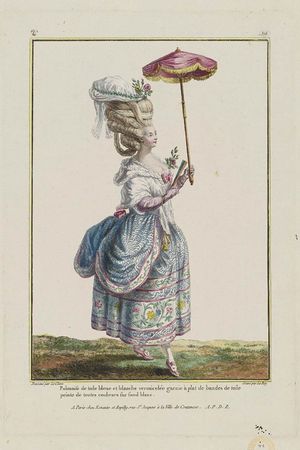Annotation:Polonese (1) (The): Difference between revisions
m (Andrew moved page Annotation:Polonese (The) to Annotation:Polonese (1) (The)) |
m (Text replacement - "garamond, serif" to "sans-serif") |
||
| Line 1: | Line 1: | ||
=='''Back to [[{{BASEPAGENAME}}]]'''== | =='''Back to [[{{BASEPAGENAME}}]]'''== | ||
---- | ---- | ||
<p><font face=" | <p><font face="sans-serif" size="4"> | ||
'''POLONESE, THE.''' English, Country Dance Tune or Jig (6/8 time). G Major. Standard tuning (fiddle). AABB. The tune was fist published in Samuel, Ann & Peter Thompson's '''24 Country Dances for the Year 1787''' (p. 21), reprinted in their '''200 Favourite Country Dances, vol. 5''' issued the next year. A Polonese or Polonaise [http://en.wikipedia.org/wiki/Polonaise] was the name for a dance in 3/4 time that originated in Poland ('Polonaise' means Polish), however, 'Polonese/Polonaise also refers to a woman's garment of the later 1770s and 1780s that consisted of a petticoat or underskirt, over which was worn a gown with a cutaway [http://en.wikipedia.org/wiki/Polonaise_(clothing)]. It too was said to have been inspired by Polish costume. [[File:polonaise.jpg|300px|thumb|right|]] | '''POLONESE, THE.''' English, Country Dance Tune or Jig (6/8 time). G Major. Standard tuning (fiddle). AABB. The tune was fist published in Samuel, Ann & Peter Thompson's '''24 Country Dances for the Year 1787''' (p. 21), reprinted in their '''200 Favourite Country Dances, vol. 5''' issued the next year. A Polonese or Polonaise [http://en.wikipedia.org/wiki/Polonaise] was the name for a dance in 3/4 time that originated in Poland ('Polonaise' means Polish), however, 'Polonese/Polonaise also refers to a woman's garment of the later 1770s and 1780s that consisted of a petticoat or underskirt, over which was worn a gown with a cutaway [http://en.wikipedia.org/wiki/Polonaise_(clothing)]. It too was said to have been inspired by Polish costume. [[File:polonaise.jpg|300px|thumb|right|]] | ||
<br> | <br> | ||
<br> | <br> | ||
</font></p> | </font></p> | ||
<p><font face=" | <p><font face="sans-serif" size="4"> | ||
''Source for notated version'': | ''Source for notated version'': | ||
<br> | <br> | ||
<br> | <br> | ||
</font></p> | </font></p> | ||
<p><font face=" | <p><font face="sans-serif" size="4"> | ||
''Printed sources'': Thompson ('''Compleat Collection of 200 Favourite Country Dances, vol. 5'''), 1788; p. 21. | ''Printed sources'': Thompson ('''Compleat Collection of 200 Favourite Country Dances, vol. 5'''), 1788; p. 21. | ||
<br> | <br> | ||
<br> | <br> | ||
</font></p> | </font></p> | ||
<p><font face=" | <p><font face="sans-serif" size="4"> | ||
''Recorded sources'': <font color=teal></font> | ''Recorded sources'': <font color=teal></font> | ||
</font></p> | </font></p> | ||
Revision as of 14:34, 6 May 2019
Back to Polonese (1) (The)
POLONESE, THE. English, Country Dance Tune or Jig (6/8 time). G Major. Standard tuning (fiddle). AABB. The tune was fist published in Samuel, Ann & Peter Thompson's 24 Country Dances for the Year 1787 (p. 21), reprinted in their 200 Favourite Country Dances, vol. 5 issued the next year. A Polonese or Polonaise [1] was the name for a dance in 3/4 time that originated in Poland ('Polonaise' means Polish), however, 'Polonese/Polonaise also refers to a woman's garment of the later 1770s and 1780s that consisted of a petticoat or underskirt, over which was worn a gown with a cutaway [2]. It too was said to have been inspired by Polish costume.

Source for notated version:
Printed sources: Thompson (Compleat Collection of 200 Favourite Country Dances, vol. 5), 1788; p. 21.
Recorded sources:
